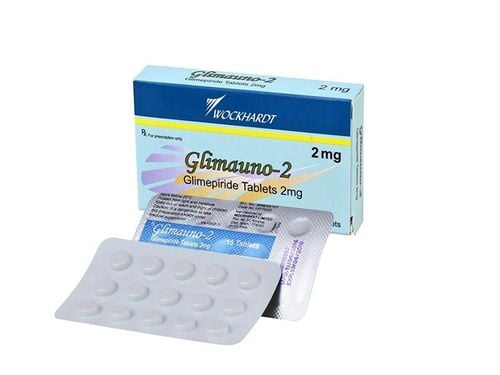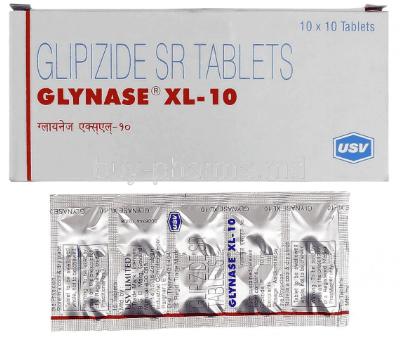This is an automatically translated article.
Glimepirid 4mg contains the active ingredient Glimepiride, which belongs to the group of drugs used to treat diabetes. The drug is indicated in a supportive treatment regimen for diet and exercise to help lower blood glucose in patients with non-insulin dependent diabetes mellitus (type 2 diabetes). Let's learn about the uses and notes when using Glimepiride through the article below.
1. Uses of Glimepiride
1.1. Indications Glimeprid contains the active ingredient Glimepiride - a sulfonylurea type 2 diabetes drug. It is indicated as an adjunct to diet and exercise to help lower blood glucose in patients with non-insulin dependent diabetes mellitus (type 2 diabetes mellitus) when blood glucose levels cannot be controlled by diet. diet, exercise.
1.2. Pharmacodynamics Glimepiride belongs to the group of sulfonylurea - a group of drugs used to treat type 2 diabetes. The drug works by the mechanism of increasing insulin secretion from the beta cells of the pancreas. In addition, Glimepiride also has extra-pancreatic effects, playing an important role in the drug's action, helping to increase the sensitivity of peripheral tissues to insulin.
1.3. Pharmacokinetics Glimepiride is completely absorbed from the gastrointestinal tract. Peak plasma concentrations are reached within 2 to 3 hours. Glimepiride is strongly bound to plasma proteins. Metabolism of the drug produces two major metabolites, a hydroxy derivative and a carboxy derivative. The half-life (t1/2) of Glimepiride is approximately 9 hours. Approximately 60% of the dose is excreted in the urine and 40% of the dose is excreted in the feces.
2. Dosage of Glimepiride
Glimepiride 4mg is taken orally. The drug should be taken 1 time per day with breakfast or the first main meal of the day.
Dosage depends on the patient's condition and tolerability. Specifically as follows:
Initial dose in previously untreated patients: The usual dose of Glimepiride in adults is 1-2mg x 1 time/day. In debilitated, malnourished or elderly patients, patients with liver failure, renal failure, patients at risk of hypoglycaemia, the starting dose should be 1 mg/time/day; Initial dose in patients already treated with other classes of antidiabetic drugs: The usual adult dose is 1-2 mg/day. Note that the maximum starting dose should not exceed 2mg/day; Maintenance dose: The usual maintenance dose should be from 1 to 4 mg/time/day. In patients already treated with Glimepiride 1 mg/day, the dose may be increased to 2 mg/day if blood glucose levels are still not reaching the desired range after 1-2 weeks of treatment. After the dose is titrated to 2 mg, subsequent dose adjustments may depend on the patient's tolerability and response to treatment. Dosage adjustment should be increased slowly, each increase not more than 2 mg / day, 1-2 weeks apart. Note that the maximum recommended dose of Glimepiride is 8 mg/day.
3. Undesirable effects of the drug Glimepiride
Some unwanted effects may be encountered when using Glimepirid 4mg as follows:
Dizziness, hypoglycemia, weakness, nausea, headache; Side effects on the stomach - intestines: Gastrointestinal pain, vomiting, diarrhea, in rare cases patients may increase liver enzyme levels, hepatitis, impaired liver function (jaundice, cholestasis); Skin reactions: Allergic vasculitis, photosensitivity, porphyria; Hematology: Agranulocytosis, leukopenia, hemolytic anemia, thrombocytopenia, pancytopenia and aplastic anemia; Metabolism: Disulfiram reaction and hepatic porphyria, decreased plasma sodium concentration, syndrome of inappropriate antidiuretic hormone secretion - ADH; Other side effects: Blurred vision and/or changes in eye accommodation.
4. Notes when using Glimepiride
4.1. Contraindications Contraindicated to use Glimepirid 4mg in the following cases:
Patients with hypersensitivity to Glimepiride, sulphonamides, sulfonylureas or any of its ingredients; Patients with insulin-dependent diabetes, diabetic ketoacidosis, diabetic coma; Patients with impaired kidney function, liver function: Should switch to insulin treatment; Pregnant women, lactating women. 4.2. Some precautions when using Glimepirid 4mg are as follows:
Patients should be informed of the potential risks when using the drug, the benefits of treatment with Glimepirid as well as the regimen options. Alternative treatment..
Glimepirid in particular and sulfonylurea drugs in general have the potential to cause severe hypoglycemia:
Patients with renal failure are more sensitive to the hypoglycemic effect of Glimepirid; Patients with malnutrition, liver failure, adrenal insufficiency or pituitary insufficiency are particularly sensitive to the hypoglycemic effect. Symptoms of hypoglycaemia are less noticeable in the elderly, who are being treated with beta-channel blockers or other sympathomimetic agents; Symptoms of hypoglycaemia usually occur when the body's caloric intake is not enough, after long and heavy physical activity, the patient regularly drinks alcohol or simultaneously takes two (or more drugs) causing hypoglycaemia. ; The combined use of insulin, metformin, and glimepiride may increase the risk of hypoglycemia. Loss of blood glucose control: This can occur in patients who are already stable on a diabetes regimen but have stressors such as trauma, fever, surgery, or infection. At that time, it is necessary to use insulin in combination with glimepiride or insulin alone.
Patients treated with Glimepiride should be periodically monitored for blood glucose levels to determine the level of treatment response. The effectiveness of glycemic control during long-term therapy should be assessed by monitoring glycosylated hemoglobin every 3 to 6 months.
5. Glimepiride drug interactions
Glimepirid 4mg may cause drug interactions as follows:
Combined use of Glimepiride with non-steroidal anti-inflammatory drugs (NSAIDs) and drugs that are strongly bound to plasma proteins such as sulfonamides, salicylates, coumarins, chloramphenicol, inhibitors monoamine oxidase inhibitors, probenecid and beta blockers increase the risk of hypoglycemia; Combination use of Glimepiride and the following drugs may increase blood glucose levels and lead to loss of blood glucose control: Corticosteroids, sulfonuylureas, thiazide diuretics, phenothiazines, thyroid products, oral contraceptives oral, estrogen, nicotinic acid, isoiazid and sympathomimetic; The combined use of oral antidiabetic agents with miconazole has been reported to cause severe hypoglycaemia; Interactions may occur when Glimepiride is co-administered with cytochrome P459 2C9 inducers such as rifampicin. Glimepirid 4mg contains the active ingredient Glimepiride, which belongs to the group of drugs used to treat diabetes. The drug is indicated in a supportive treatment regimen for diet and exercise to help lower blood glucose in patients with non-insulin dependent diabetes mellitus (type 2 diabetes). To ensure the effectiveness of treatment and avoid unwanted side effects, patients need to use prescription drugs or consult a doctor or pharmacist for advice.
Follow Vinmec International General Hospital website to get more health, nutrition and beauty information to protect the health of yourself and your loved ones in your family.
Please dial HOTLINE for more information or register for an appointment HERE. Download MyVinmec app to make appointments faster and to manage your bookings easily.













